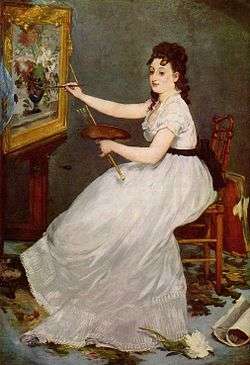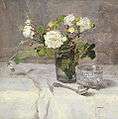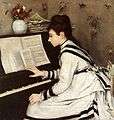Eva Gonzalès

| Wikimedia Commons has media related to Eva Gonzalès. |
Eva Gonzalès (April 19, 1849 – May 6, 1883) was a French Impressionist painter.
Life and career
Eva Gonzalès was born in Paris into the family of the writer Emmanuel Gonzalès.[1] In 1865, she began her professional training and took lessons in drawing from the society portraitist Charles Chaplin.[2]
Gonzalès became a pupil of the artist Édouard Manet in February 1869.[3] Manet is said to have begun a portrait of her at once which was completed on 12 March 1870 and exhibited at Salon in that year.
Like her teacher, Édouard Manet, she never exhibited with the Impressionist painters in their controversial exhibitions in Paris, but she is considered part of the group because of her painting style. She was Manet's only formal student and modeled frequently for several members of the Impressionist school. Gonzalès posed for Manet in 1869 for the painting Portrait of Mlle Gonzalès, a work which has previously been discussed more than Gonzalès' oeuvre at her own 1885 retrospective and at Galerie Daber's exhibition for her work in 1950.[4]
While studying under Manet, Gonzalès self-portraits suggest she was exploring her individuality and identity as an artist by presenting subtle correctives to Manet's version of her. Until 1872, she was strongly influenced by Manet but later developed her own, more personal style. This can be seen in works such as Enfant de Troupe (1870), which is a nod to Manet's Le Fifre (1866), while many of her later paintings involved portraits of her sister, Jeanne.[5]
During the Franco-Prussian War she sought refuge in Dieppe.[2]
She married the graphic artist, and Manet's engraver, Henri Guérard in 1879, and used him and her sister Jeanne Gonzalès[6] as the subjects for many of her paintings.[7]
One such painting is Une Loge Aux Italiens (1874), which depicts a male and female figure, modelled after Gonzalès' husband and sister, in the box of a theatre. This was a subject matter frequently chosen by Impressionist painters, and there are many direct references to Manet's work. The female figure is pale-skinned and wears a light blue dress that sets a sharp contrast against the dark background, reminiscent of works by Manet such as The Balcony (1868) or even his famous Olympia (1863). The flowers in Une Loge Aux Italiens also seem to have been quoted from the bouquet in Olympia. There are also clues that Manet might have been directly involved with the creation of this painting, as there is a pastel sketch version of this work that was made by him.[8]
Her work was exhibited at the offices of the art review L'Art in 1882 and at the Galerie Georges Petit in 1883. Her career was cut short when she died in childbirth at the age of thirty-four,[1] exactly six days after the death of her teacher, Manet.
In 1885, after her death a retrospective of 88 works was held at the Salons de La Vie Moderne.
Gallery
 Lady With A Fan, 1869-1870
Lady With A Fan, 1869-1870
- Enfant de troupe, Musée Gaston Rapin, Villeneuve-sur-Lot, France, 1870

 Afternoon Tea or On the Terrace, Private Collection 1875
Afternoon Tea or On the Terrace, Private Collection 1875 An actress with a mask, Private Collection
An actress with a mask, Private Collection.jpg) L'Avant Port (Dieppe), Private Collection
L'Avant Port (Dieppe), Private Collection L'Indolence, Private Collection 1871-72
L'Indolence, Private Collection 1871-72 La Toilette, Private Collection 1879
La Toilette, Private Collection 1879 La jeune élève (Portrait of Sister as Artist), Private Collection 1871-72
La jeune élève (Portrait of Sister as Artist), Private Collection 1871-72 Le petit lever, Private Collection 1875
Le petit lever, Private Collection 1875
 Nounou avec enfant, National Gallery of Art, Washington D.C. 1877-78
Nounou avec enfant, National Gallery of Art, Washington D.C. 1877-78 Portrait of Jeanne Gonzales in Profile, Private Collection
Portrait of Jeanne Gonzales in Profile, Private Collection Portrait of a Woman in White, Private Collection 1879
Portrait of a Woman in White, Private Collection 1879 Reading in the Forest, Musée du Petit Palais, Paris 1880
Reading in the Forest, Musée du Petit Palais, Paris 1880 Roses dans un verre, Private Collection 1880-82
Roses dans un verre, Private Collection 1880-82 Secretly, Private Collection 1877-78
Secretly, Private Collection 1877-78 The Milliner, The Art Institute of Chicago c.1877
The Milliner, The Art Institute of Chicago c.1877 Une loge aux Italiens, Musée d'Orsay, Paris 1874
Une loge aux Italiens, Musée d'Orsay, Paris 1874 White Shoes, Private Collection 1879-80
White Shoes, Private Collection 1879-80 Woman in White, National Museum of Women in the Arts, Washington D.C. 1879
Woman in White, National Museum of Women in the Arts, Washington D.C. 1879
References
- 1 2 Heller, Nancy G. (1987). Women Artists. New York: Abbeville Press. p. 94..
- 1 2 Gaze, Delia (1997). Dictionary of Women Artists. Chicago: Fitzroy Dearborn Publishers. p. 598.
- ↑ "Edouard Manet - Eva Gonzalès - NG3259 - National Gallery, London". Retrieved 10 October 2016.
- ↑ Emmer, Janalee. "Dr." (PDF). http://www.huichawaii.org/. Ohio Wesleyan University. Retrieved March 7, 2015. External link in
|website=(help) - ↑ Riding, Alan (1993-10-28). "3 Artists Who Left A Fainter Impression". The New York Times. ISSN 0362-4331. Retrieved 2017-03-08.
- ↑ After a quote from Curator of "Women Impressionists" Exhibition at the Marmottan Museum http://www.nytimes.com/1993/10/28/arts/3-artists-who-left-a-fainter-impression.html
- ↑ Riding, Alan (1993-10-28). "3 Artists Who Left A Fainter Impression". The New York Times. ISSN 0362-4331. Retrieved 2017-03-08.
- ↑ "Musée d'Orsay: Eva Gonzalès A Box at the Theatre des Italiens". www.musee-orsay.fr. Retrieved 2017-03-08.
Further reading
- Marie-Caroline Sainsaulieu, Jacques de Mons: Eva Gonzalès: 1849 - 1883; étude critique et catalogue raisonné . Paris 1990
- Marianne Delafond: Les femmes impressionnistes: Mary Cassatt, Eva Gonzalès, Berthe Morisot. Paris 1993 ISBN 2-85047-227-1
External links
- National Gallery London. Notes. Accessed March 2015
- Olga's Gallery Notes. Accessed March 2015
- Spaightwood galleries Biography. Accessed March 2015